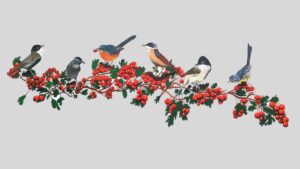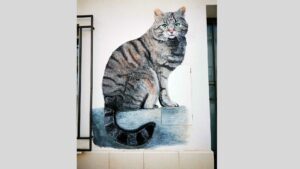12. Queen of the night
A very clever civet cat
Civet cat trying to eat merlot grapes
About these mammals
Some curiosities about these mammals
Civet cats (Genetta genetta) are carnivores of the family of the viverridae that have a certain resemblance to cats but with a snout like mongooses and with arboreal habits, they are designed to climb and jump, they are elongated with an abundant grey coat with unique black spots on each specimen which allows to be identified them when they are studied. They have a long tail, it reaches a length that exceeds the length of the body with the head and is very thick with eight to ten black rings, in front of the eyes, which are brown and with vertical pupils very adapted to the dark, on the snout they have a very characteristic dark spot. They have short but very agile legs with pads and claws which make them very silent and magnificent climbers. It is a great hunter, very agile, extremely silent, with acrobatic jumps that reach far away points with incredible precision, they use their tail to balance the intense strength of their legs, they have retractile claws very adapted to capture prey and they usually have them covered to protect their vital weapons. They kill their medium-sized prey with a bite to the neck and eat them on the moment, so they do not usually hide their hunt like other species.
We only have the civet cat as the unique representative of the viverridae in Spain, and as no remains have been found in archaeological research older than 2000 years, it is known that it was an animal that was linked to man as a domestic animal because of its ability to capture rodents and for this reason it arrived in our peninsula, possibly later ending up in the wild and its plasticity and adaptation has allowed to be a magnificent specie of our local fauna. On the mainland we have a subspecies (Genetta genetta isabelae) on the island of Ibiza, which is smaller in size and has adapted its life to the smaller prey on the island.
Civet cats mark their territory in various ways, defecating and urinating in the same places and rubbing their perianal glands on high points so that the wind can spread their scent. They have extensive home ranges, larger for males than for females, which change in size depending on the amount of prey available depending on the seasons, being easier for them to capture in autumn and winter, so their movements are smaller. They sleep in burrows, which are usually large nests of raptors in trees and inside bushes or very dense thorns on the ground.
The civet cats live for six to eight years in the wild, in a domestic situation they can live for more than 15 years. The rut goes from January to September and after a gestation period of 55 to 65 days they have 1 to 4 offspring, normally two or three. As they are born weighing only 80 g and with their eyes closed, they must be suckled by their mother for about three weeks and from then on they can eat meat and milk scraps until they are 4 months old, they become independent at 9 months, in the last 4 or 5 months they will hunt near the den and share the territory with their mother, who will chase them out of the den at the next birth to prevent them from harming their new siblings. They become sexually adult at the age of 2 years. There is no sexual dimorphism, so it is not possible to tell whether a civet cat is male or female without hand contact with the animal.
Civet cats are especially carnivorous, feeding on rodents, birds, rabbits and hares, they also feed on amphibians and reptiles, as well as insects, but they eat fruit when available, often eating berries, plums and grapes if available.
They like to live in trees, in wooded and isolated areas, they are not frequent in urban areas or in steppes or wooded areas, they are frequent on banks with poplars and dense bushes.
The genet faces many problems in its population due to the reduction of its habitat as well as the disappearance of its hunting prey due to diseases such as rabbits, it is often damaged by being run over. Although it is not currently in danger of extinction, it has suffered a reduction in its population due to being registered as vermin and suffering from a bad reputation as a result of lack of knowledge and misinformation. It is an essential mammal in the food chain, a great controller of rodent populations and other species that only has the misfortune of sharing prey with hunters, hence its undeserved generalised contempt.
How it was done
Discover how this Painting was made
This work was carried out over a period of 3 weeks and has several features that make it somewhat difficult, such as its position on the wall, the fact that it is a very narrow and high space and the roughness of the wall itself, as well as the fact that it is not entirely white, which makes it much more difficult to correct mistakes. It is about 2 metres high, including the touching where it is supported, and it could be done with scaffolding. The fur was covered individually with various colours ranging from white to dark grey and black.
ROUTE OF PAINTINGS
The Painting Route through Vélez-Blanco continues
This painting is located on the façade of a neighbour of Vélez Blanco, it is located on the upper part next to a balcony and its dimensions are 0.68 m wide and 1.93 m high. You can see other works by following our street route in Vélez Blanco.
BOOKINGS
Book your exclusive stay at The House of the Birds
You will discover a different kind of rural accommodation, with all the comforts of a completely restored house but with a rural feel. With fireplace, wine cellar, games room, table football room, spacious lounge, comfortable bathrooms, fully equipped kitchen and in the heart of a unique village with its beauty as is Vélez Blanco.



